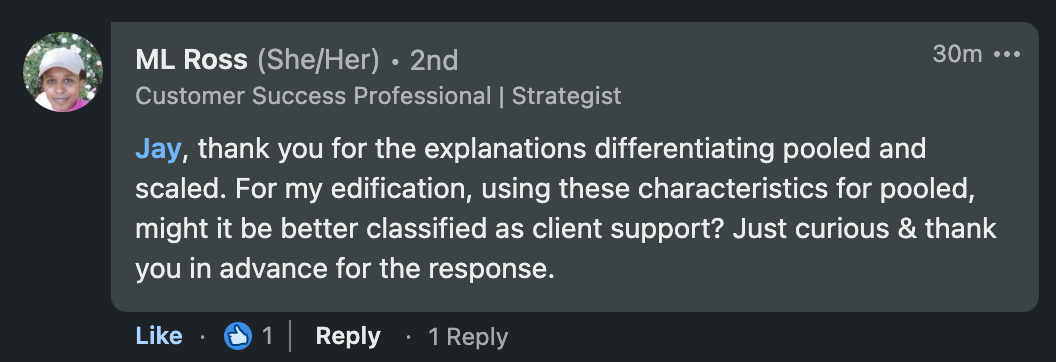The next 12 to 18 months are going to be interesting.
Many economists believe that the current recessionary environment will continue to degrade before it improves, and nearly every day, we see more bad news for the tech sector.
This recession is an inflection point for B2B SaaS and other subscription-based businesses. We’ve enjoyed 13+ years of prosperity fueled by near-endless cash supplies from investors hungry to participate in one of the hottest business sectors on the planet.
Meanwhile, the customer success movement progressed rapidly, and now faces one of its first true tests in the coming quarters.
Executive teams, CFOs, and boards will heavily scrutinize customer success spending like they do every business function.
The reckoning is here.
For customer success to remain viable, we must adopt scalable strategies that provide outsized business value in exchange for the dollars we invest in them.
To this end, I see two common approaches for scaling customer success organizations.
Pooled and scaled customer success.
At first glance, they seem similar, but they are far from it.
Let’s look at both.
Pooled customer success
In a pooled customer success model, we assign a segment of customer accounts to a group – a pool – of CSMs. The pool’s job is to handle the needs of each customer as requested, by engaging with the customer on a one-to-one basis.
For example, when a customer hires a new employee who needs to use your product, they might submit a request to the pooled team (via a case management tool) to provide onboarding for the new user.
The request is assigned to the next available CSM in the pool who schedules time with the new user, conducts the onboarding session, and sends the user on their way.
Each CSM handles a number of these requests in any given week.
The pooled approach is most commonly applied to the “long tail” customer segment, where there are a high volume of accounts with low annual contract values.
If this model feels like customer support, it should. Pooled customer success is similar to the case-based, round-robin motion that customer support teams use.
It is only different in terms of content. New user onboardings, best practices consultations, and training often fall outside the purview of support teams who are more geared toward broke/fix issue resolution vs. strategic issues.
An astute observation by ML Ross to my Saturday afternoon LinkedIn post on this topic.
While some relationships will develop over time, the pooled model is not inherently relationship-based. One of any number of CSMs in the pool could handle a customer’s request on any given day.
While the pooled customer success model is a great starting point that allows us to capture valuable data about customer needs, it’s not the ultimate solution for scale.
Enter scaled customer success
Scaled customer success is quite different from the pooled model.
A scaled cs team begins its work by analyzing available customer data to identify common customer needs that drive the most effort for customer success managers. Once the team identifies priorities, it builds programs designed to serve each specific need in a scalable way.
In the new user onboarding example above, the scaled cs team might create a program that includes a bi-weekly live webinar, learning videos, and relevant new user guides deployed through the customer community.
CSMs, rather than field five new user calls per week, can now run two new user webinars each month where new users across all customers can join and get the onboarding they need to get started. Attendance in this program triggers automated content delivery to the user, further enabling their onboarding and education experience.
The team will market this program to customers through various channels such as the customer newsletter, community, CSM calls, and in-product notifications to ensure they know it exists and how to take part in it.
The customer success manager, who previously fielded five new user onboarding calls per week (~250 per year!!), now suddenly has more daylight in their calendar.
Imagine all the other program possibilities – new users, low usage situations, high customer support cases, new product feature education, and digital customer success plan development.
As the library of programs expands, additional CSM time becomes available, which they can use to plan additional programming and engage in highly targeted, high-value retention and expansion conversations.
A virtuous cycle.
The programmatic approach helps the team become more strategic, but the benefits don’t stop there.
A program’s quality is easier to manage than one-off CSM activities conducted dozens or hundreds of times. Scaled programs also reduce repetitive tasks that cause CSM burnout, and they benefit ALL customers, from enterprise to SMB, even if only targeted at the long tail of small customers
…
Pooled and scaled customer success are two completely different strategies. While pooled is a decent place to start, most companies will benefit the most from the scaled approach.
As you plan for 2023, how will you pivot existing customer success team resources to scale?
👊
💡 Weekly Favorites
Here are some of my favorite podcasts, blogs, and videos from the week:
Last week we published a Gain Grow Retain podcast episode featuring the scaled customer success team from Pendo.io. It was the inspiration for this post. Give it a listen, and let me know what you think.More for less: Five ways to lower cloud costs without destroying value. An interesting article from McKinsey on how our customers are assessing the value of our products right now.
See you next Sunday.
Do you want to share this issue of customersuccess.io via text, social media, or email? Just copy and paste this link:
www.customersuccess.io/scaled-vs-pooled/

